April 13, 2020 — It was not a scenario for which they had trained.
As the astronauts set to be the fifth and sixth people to walk on the moon, Jim Lovell and Fred Haise had undergone months of extensive preparation to carry out every aspect of NASA's Apollo 13 mission — including what to do if something went wrong.
But two days after their successful launch on April 11, 1970, mission commander Lovell, lunar module pilot Haise and command module pilot Jack Swigert were thrown into an emergency for which there was no plan. Fifty years ago today (April 13), the Apollo 13 crew "had a problem."
"Problem solving with the system we had was suited to what we had to get done, as every mission had problems to deal with," Haise said in an interview with collectSPACE. "But we never considered an explosion, in the sense of being able to work around that."
"Normally, that would manifest in a loss of the vehicle and crew," he said.
And yet, that was exactly what Haise, Lovell and Swigert, as well as the teams of engineers in Mission Control, had to deal with. An oxygen tank, which had been unknowingly damaged during a pre-flight test, exploded, tearing apart the service module that provided the critical power and life support systems for the Apollo 13 command module.
Not only did the explosion rule out any chance of achieving a moon landing, it threatened to strand the astronauts in deep space. That they made it home safely, was as much due to the ingenuity of the teams that worked the problem on the ground as it was a matter of fortunate timing.
"The explosion occurred on April 13, at just the right time to allow a return," said Lovell. "If the explosion occurred when we had lit our engine to go to the moon, in the beginning, we would have never had enough consumables in the lunar module to go all the way around the moon and come back home again. If the explosion occurred after we got into lunar orbit, or, heaven forbid, when we were on the lunar surface, Mission Control would have had to figure out why they left three guys at the moon."
Lovell and Haise spoke to collectSPACE about the 50th anniversary of the Apollo 13 mission (Swigert died of cancer in 1982). The two participated in separate interviews; their replies are presented together to comprise a single conversation.
collectSPACE (cS): After the explosion itself, was there a point where you felt that your chances of returning to Earth were not looking good?
James Lovell: When I noticed the red warning light saying that two out of our three fuel cells had just died, that was kind of a shock to me because that is where we got our electrical power for the whole flight. We would have to rely on battery power, which in the command module we didn't think would be sufficient.
It was a feeling of, "Holy cow! We have something really wrong here."
And I don't know why I did this, but I looked out the right window and that's when I saw that at a high rate of speed gas was escaping from the spacecraft. You could see a little plume of it. I then glanced at the oxygen gauges and one read zero and another was in the process of going down. That is when I really felt we were in a very dangerous situation.
Fred Haise: Before you go on one of these missions, you assume necessarily you're not going to get back.
I had no idea about the percentage [or] what odds there were. It was a matter of working through it with a number of the challenges and [hoping] that someone on the ground working at Mission Control would find the answers.
cS: Was there a point where you felt more confident about your survival?
Haise: I think the first time I thought we really had a chance to surely make it back was right after the first use of the lunar module's descent engine. We were then on a free return to get around the moon.
Jim Lovell asked me to compute the consumables, which I did, and I figured we would make it with power. I assumed the power we'd go down to was 18 amps — after that, we'd have to apply a lot more brain power if we got down even lower. But even at that level and even if we had a much longer return, we still made it on six batteries in the lunar module.
[I calculated] we'd run short of water about five hours before entry interface, but I knew from Apollo 11 data, where we deliberately had Neil [Armstrong] and Buzz [Aldrin] turn off the water before they left their lunar module in orbit and watched the systems die, that the first system to die was at about eight hours. So we were probably okay with water.
The one I did not figure, which actually turned out to be the most critical, was the lithium hydroxide [LiOH] cartridges. It didn't even occur to me.
[cS: The LiOH canisters scrubbed carbon dioxide from the cabin air. The solution, which called for using the command module's incompatible canisters in the lunar module, famously involved jerry-rigging a way to fit a literal square peg in a round hole using nothing but the spare parts they had aboard the spacecraft.]
cS: What if Apollo 13 never had a problem. Had you given any thought as to what were going to be your first words stepping onto the moon?
Haise: No, I wasn't planning any first words on the moon. I don't know if Jim was, he would have been the first out.
Lovell: No, this was 13, not Apollo 11.
Haise: Really I felt by that time, we were kind of past the historic things you might do. I was just really eager to get down the ladder and start to work.
cS: Okay, history aside, what about personal touches? Charlie Duke famously left a photo of his family on Apollo 16 and Gene Cernan wrote his daughter's initials in the lunar soil on Apollo 17, things like that.
Lovell: I really did not think about leaving something personal on the moon. I guess maybe I should have.
cS: What about the Navy anchor decal that decorated the front of your LEVA (Lunar Extravehicular Visor Assembly) that was part of the helmet you wore on the moon? No other astronaut decorated theirs.
Lovell: I didn't realize that. Someone very nicely did that for me, whoever got our suits ready. It wasn't until we started training with it that I saw that it was there.
cS: Fred, did you have any personal activities planned?
Haise: No, but I probably would have. In the days following the explosion, when I went to get some food, I found in the lunar module some family pictures that had been placed there. If I found those during the landing, I probably would have taken them out and put them on the moon.
cS: As history played out, the closest that you came to the moon was from above, as you looped around the far side before heading back to Earth. Jim had been there before on Apollo 8, but for you, Fred, this was your first look at the moon from up close. Was the sight out the window a momentary relief from the situation you were in?
Haise: Looking down at the moon, we could view Fra Mauro, our site where we planned to land. It wasn't an overwhelming kind of emotion at that point; it was just a continuation of the feeling of disappointment that we were not going to be able to do as we trained and set out to do.
cS: The explosion occurred because of an electrical short in one of the oxygen tanks, but that belies a longer chain of events that trace back before you launched. Did you have any indication at that time that anything was wrong, such that you or someone else could have, but didn't catch it before it became a problem?
Lovell: In hindsight, if you really analyze the construction and work that was done prior to the flight, you could have seen where there would be a possible problem.
Things that happened on Apollo 13 that should not have happened started a year or more before the flight, when the oxygen tank was dropped at the factory. It had originally been intended to fly on Apollo 10 and, of course, it was rechecked for its ability to feed liquid oxygen to the fuel cells and checked out perfectly.
But the thing they did not check was the ability to remove liquid oxygen from the tank. There was piping and other associated equipment at the back of the tank that would allow the ground crew to remove the liquid oxygen after a routine test, prior to securing the spacecraft. And that had been damaged.
Consequently, removing the liquid oxygen was not possible after our countdown demonstration test two weeks before the flight. So the ground crew took the available power that was at the Cape, which was 65 volt power — the spacecraft used 28 volt power — and used it to power heaters in the tank to boil off the liquid oxygen.
That worked perfectly, except for what was not known: the higher voltage exceeded the design of the tank's thermostats, which resulted in the temperature in the tank being allowed to get higher and higher. The tank didn't blow, like you think it would, and so it went undetected and the heat damaged all of the wiring inside the tank, leaving it bare.
A day before the launch, we filled the tank back up with liquid oxygen again. At that point, it was a bomb waiting to go off... It's an amazing story.
cS: So with all that occurred, now in hindsight or at the time of the flight, do you or did you subscribe to triskaidekaphobia, the fear of the number 13?
Lovell: If you look back, what is the number of our mission? 13. And what time did we take off from the planet? It was 13:13 Central Standard Time. And when did the explosion occur? April 13. So it is just the continuation of the bad news of 13.
Haise: I've never been superstitious, but I did get some letters reflecting on 13 being the mission number as being unlucky. I also got letters from Italy where they pointed out that in the other sense, 13 was lucky in Italy.
I had no sense at all, nor do I relate to the launch time all the other thirteens that people have tried to tie to things as being connected with the flight. I never thought of it in a superstitious sense that we would have a problem on 13. |
|
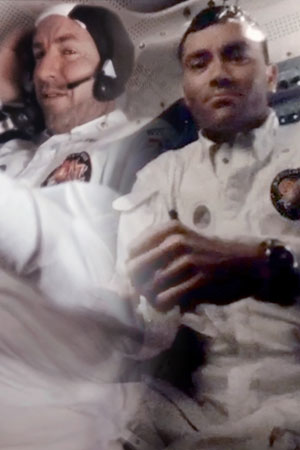
Apollo 13 astronauts James Lovell (at left) and Fred Haise, as seen in a composite of 16mm images from the 1970 mission. (NASA, as processed by Andy Saunders/Stephen Slater)
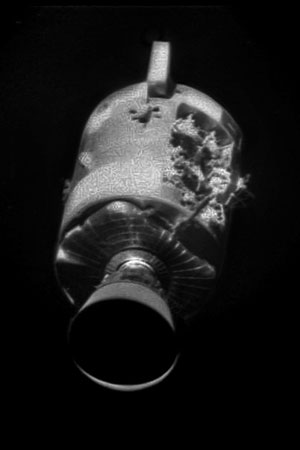
Apollo 13's damaged service module as photographed by the crew after its separation from the command module near the end of the April 1970 moon mission. (NASA, as processed by Andy Saunders)
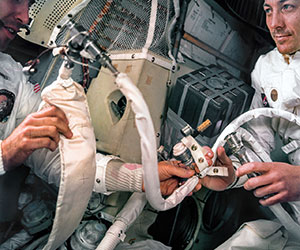
Apollo 13 astronauts Jim Lovell (at left) and Jack Swigert work with water hoses aboard the lunar module. A jerry-rigged carbon dioxide scrubber (or LiOH canister) is attached to the wall besides Swigert. (NASA/ASU, composite by Andy Saunders)
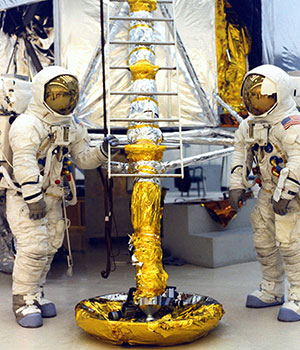
Apollo 13 astronauts Jim Lovell (at left) and Fred Haise pose at the base of a lunar module simulator in January 1970. (NASA)
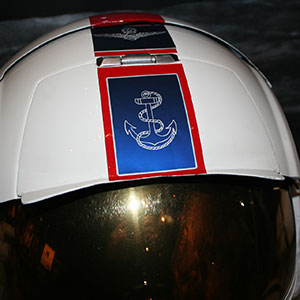
Jim Lovell's Apollo 13 LEVA (Lunar Extravehicular Visor Assembly) with Navy anchor decal. (Retro Space Images/J.L. Pickering)
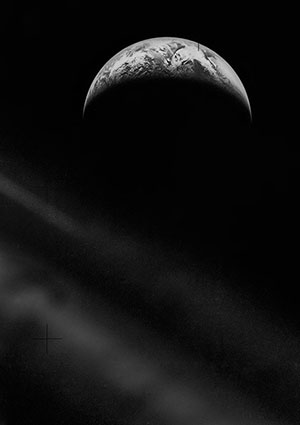
Earth out the window from aboard Apollo 13. (NASA, as processed by Andy Saunders)
|
